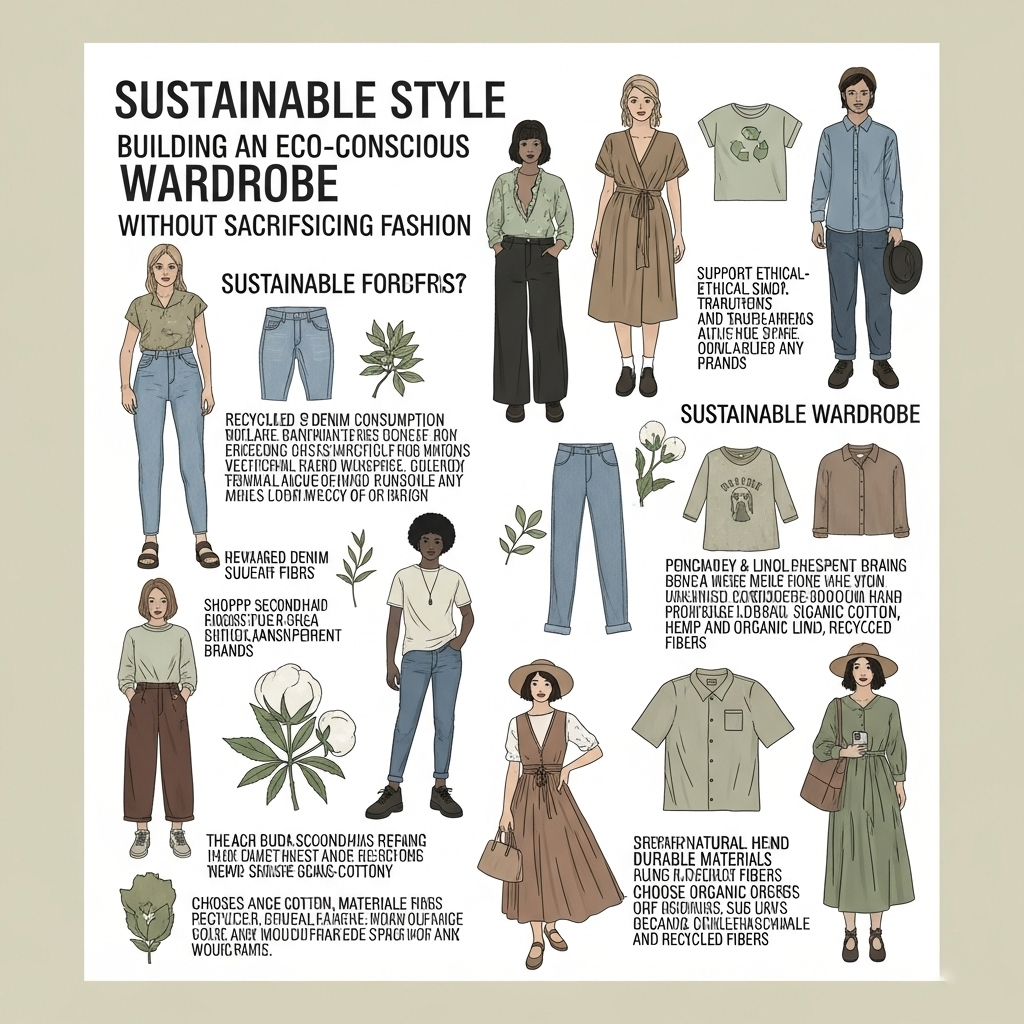
In an era increasingly defined by environmental consciousness, the fashion industry, historically a significant contributor to pollution and waste, is undergoing a much-needed transformation. Sustainable style is no longer a niche concept but a growing movement, urging consumers to make more ethical and eco-friendly choices without compromising on personal expression or aesthetic appeal. This article explores the principles of sustainable fashion and provides actionable tips on how to build an eco-conscious wardrobe that is both stylish and responsible.
At its core, sustainable fashion advocates for a shift from fast fashion’s linear “take-make-dispose” model to a circular approach that prioritizes longevity, ethical production, and minimal environmental impact. This involves considering the entire lifecycle of a garment, from the sourcing of raw materials and manufacturing processes to its eventual disposal or recycling.
Understanding the Impact of Fast Fashion:
Before diving into solutions, it’s crucial to understand the problem. Fast fashion’s business model relies on rapid trend cycles, mass production of cheap garments, and planned obsolescence, encouraging consumers to buy more frequently and dispose of clothes quickly. This leads to:
- Environmental Degradation: Excessive water consumption for cotton cultivation, chemical pollution from dyes and finishes, microplastic pollution from synthetic fabrics, and massive landfill waste.
- Unethical Labor Practices: Exploitation of garment workers, low wages, poor working conditions, and child labor in some regions.
- Resource Depletion: Overuse of non-renewable resources and depletion of natural ecosystems.
Pillars of Sustainable Style:
- Buy Less, Choose Well, Make it Last: This is the mantra of sustainable fashion. Instead of impulse purchases, invest in fewer, higher-quality pieces that will stand the test of time, both in terms of durability and timeless design.
- Quality Over Quantity: While often more expensive upfront, well-made garments from natural or recycled fibers will last longer, reducing the need for frequent replacements. This ultimately saves money and resources in the long run.
- Ethical Production: Support brands that are transparent about their supply chains, pay fair wages, provide safe working conditions, and prioritize animal welfare. Look for certifications like Fair Trade or GOTS (Global Organic Textile Standard).
- Reduce, Reuse, Recycle: Extend the life of your clothes through proper care, repair, and creative repurposing. When a garment can no longer be worn, explore textile recycling options.
Tips for Building a Sustainable Wardrobe:
- Declutter and Assess Your Current Wardrobe: Before buying anything new, go through what you already own. Identify gaps, rediscover forgotten gems, and donate or sell items you no longer wear. This helps you understand your existing style and needs, preventing redundant purchases.
- Embrace Secondhand and Vintage: This is perhaps the most impactful way to be sustainable. Shopping at thrift stores, consignment shops, vintage boutiques, and online resale platforms (like Depop, Poshmark, or ThredUp) gives clothes a second life, significantly reducing their environmental footprint. You can find unique, high-quality pieces at a fraction of the original price.
- Invest in Timeless Basics: As mentioned in Article 1, a foundation of versatile, classic pieces is crucial. These items transcend trends and can be styled in countless ways. Think plain t-shirts, well-fitting jeans, a classic blazer, and a trench coat. Prioritize natural fibers like organic cotton, linen, hemp, Tencel, or responsibly sourced wool.
- Support Ethical and Sustainable Brands: Research brands that prioritize sustainability and ethical practices. Look for companies that use eco-friendly materials, have transparent supply chains, pay fair wages, and minimize waste in their production processes. Many brands now highlight their sustainability efforts on their websites.
- Prioritize Natural and Recycled Materials:
- Organic Cotton: Grown without harmful pesticides and chemicals.
- Linen: Made from flax, it’s durable, breathable, and requires less water than cotton.
- Hemp: Strong, durable, and grows quickly with minimal water and no pesticides.
- Tencel (Lyocell): A sustainable fiber made from wood pulp in a closed-loop system, minimizing waste and chemicals.
- Recycled Polyester: Made from plastic bottles or post-consumer waste, diverting waste from landfills.
- Responsibly Sourced Wool/Cashmere: Look for certifications that ensure animal welfare and sustainable land management.
- Learn Basic Mending and Repair Skills: A missing button, a small tear, or a loose hem doesn’t mean the end of a garment. Learning to sew on a button, patch a hole, or hem a pair of pants can significantly extend the life of your clothes and save you money. Many communities offer mending workshops.
- Care for Your Clothes Properly: Follow washing instructions on garment labels. Washing clothes less frequently, using cold water, line drying instead of tumble drying, and avoiding harsh detergents can prolong their lifespan and reduce energy consumption.
- Rent or Borrow for Special Occasions: For events that require specific attire (e.g., a formal gown, a tuxedo), consider renting instead of buying. This is a cost-effective and sustainable option for garments you might only wear once.
- Repurpose and Upcycle: Get creative! An old pair of jeans can become a tote bag, a worn-out t-shirt can be cut into cleaning rags, and a beloved but damaged dress can be turned into a skirt. Look for inspiration online for DIY upcycling projects.
- Educate Yourself and Spread Awareness: Stay informed about sustainable fashion practices and the impact of your clothing choices. Share your knowledge with friends and family, encouraging them to make more conscious decisions.
Building a sustainable wardrobe is a journey, not a destination. It involves a shift in mindset from instant gratification to thoughtful consumption. It’s about appreciating the craftsmanship, understanding the impact, and choosing pieces that resonate with your values. By embracing sustainable style, you not only contribute to a healthier planet but also cultivate a wardrobe that is truly unique, enduring, and reflective of a conscious lifestyle.
